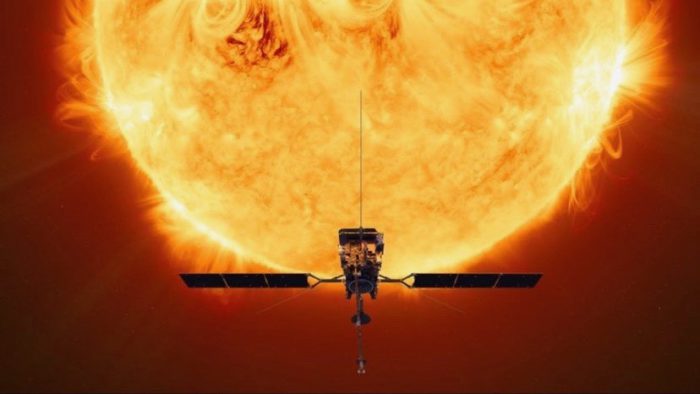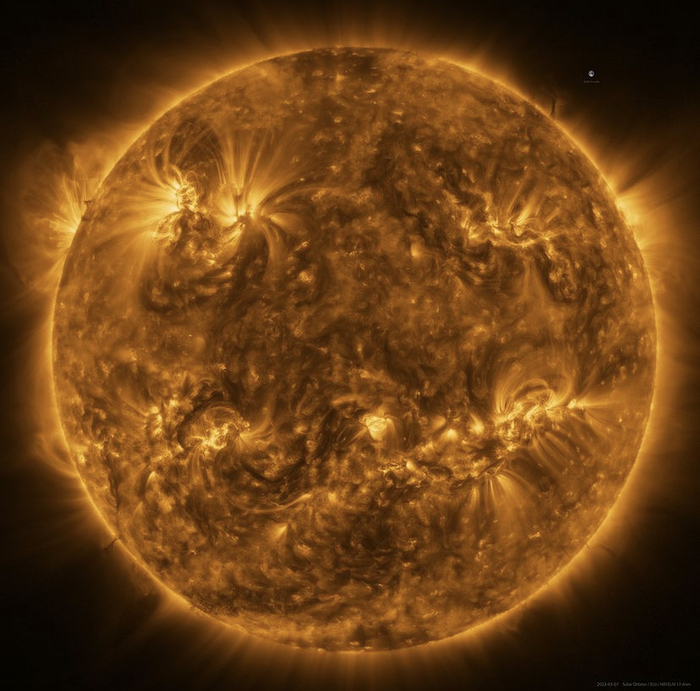Many of us have probably been told NOT to look directly into the Sun, and that’s for good reason! It is very powerful, and looking at it can hurt our eyes. But thankfully, there are telescopes and cameras that can look at it for us.
On March 7, the European Space Agency's (ESA) Solar Orbiter took brand new photos of the Sun. And now—thanks to the many instruments found on board—we can see it in more detail than ever before!
A flare for detail

This is an illustration of what scientists think the Solar Orbiter looks like next to the Sun! (@europeanspaceagency/Instagram)
The picture was taken by the Extreme Ultraviolet Imager (EUI). This is a device onboard the Solar Orbiter. It’s the highest resolution image of the Sun that has ever existed. The EUI has a resolution that’s ten times better than a 4k ultra HD TV. Pretty cool, right?
The image shows the Sun’s upper atmosphere called the corona, which has a temperature of about 1,000,000 °C (1,800,032 °F). That’s really hot. For reference, the hottest day ever recorded in Canada was 49.6 °C (121.3 °F).
How does it work?
The EUI is a very powerful telescope. It takes photos so zoomed in that 25 separate images are needed to capture the whole Sun.
So, since the telescope can take such close-up images, the spacecraft was able to be 75 million kilometres (46.6 million miles) away from the Sun when it took the pictures!
What else does this spacecraft do?

Mosaics of the Sun collected by SPICE (ESA & NASA/Solar Orbiter/SPICE team; Data processing: G. Pelouze (IAS))
While the EUI was snapping pictures, another instrument onboard called the SPectral Imaging of the Coronal Environment instrument (SPICE) was collecting data of its own.
SPICE is an imaging spectrograph that observes the Sun's atmosphere by capturing different wavelengths of ultraviolet (UV) light that come from different atoms.
In the image above, the purple figure shows the wavelengths of UV light that come from hydrogen gas atoms, the blue figure shows carbon atoms, the green shows oxygen, and, finally, the yellow shows neon.
Phew! That's a lot of science talk ... let's break it down.
UV light and wavelengths
All life on Earth relies on sunlight. Part of the sunlight that reaches our planet is visible, and part of it is not. UV light is part of the light that we can't see (and the light that gives us sunburns!).
Why can't we see it? Because it has a shorter wavelength than what is visible to the human eye!
UV light has wavelengths of 100 nanometres (nm) to 400 nm. Usually, the human eye can only see wavelengths of 380 nm to 700 nm (a nanometre is one billionth of a metre).
But this kind of light can tell us a lot about the Sun's atmosphere. According to NASA, UV light from the Sun gives scientists important information about solar storms. These storms are big explosions—called solar flares—in the Sun's atmosphere that send electromagnetic energy toward the Earth. This can lead to power outages, GPS satellite interruptions, and radio and cell phone disruptions!
So thanks to tools like SPICE, scientists can see UV light and predict how solar events will affect the Earth's space environment.
What next?
The ESA Solar Orbiter launched into space in Feb. 2020. It’ll get close enough to the Sun to get pictures and data like this 19 times. Next year, it will get even closer. It won't get as close as NASA's Parker Solar Probe, though.
Parker is the first spacecraft to fly through the corona! It'll be on its mission until 2025, so that means we'll have even more Sun content to look forward to!
 This is the highest resolution image of the Sun ever taken. An image of the Earth is also included for scale. That's us in the top right corner! (ESA & NASA /Solar Orbiter/EUI team; Data processing: E. Kraaikamp (ROB))
This is the highest resolution image of the Sun ever taken. An image of the Earth is also included for scale. That's us in the top right corner! (ESA & NASA /Solar Orbiter/EUI team; Data processing: E. Kraaikamp (ROB))









